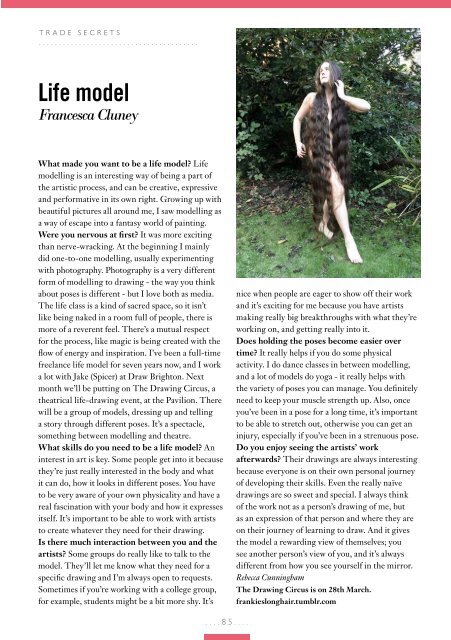Viva Brighton Issue #48 February 2017
Create successful ePaper yourself
Turn your PDF publications into a flip-book with our unique Google optimized e-Paper software.
TRADE SECRETS<br />
........................................<br />
Life model<br />
Francesca Cluney<br />
What made you want to be a life model? Life<br />
modelling is an interesting way of being a part of<br />
the artistic process, and can be creative, expressive<br />
and performative in its own right. Growing up with<br />
beautiful pictures all around me, I saw modelling as<br />
a way of escape into a fantasy world of painting.<br />
Were you nervous at first? It was more exciting<br />
than nerve-wracking. At the beginning I mainly<br />
did one-to-one modelling, usually experimenting<br />
with photography. Photography is a very different<br />
form of modelling to drawing - the way you think<br />
about poses is different - but I love both as media.<br />
The life class is a kind of sacred space, so it isn’t<br />
like being naked in a room full of people, there is<br />
more of a reverent feel. There’s a mutual respect<br />
for the process, like magic is being created with the<br />
flow of energy and inspiration. I’ve been a full-time<br />
freelance life model for seven years now, and I work<br />
a lot with Jake (Spicer) at Draw <strong>Brighton</strong>. Next<br />
month we’ll be putting on The Drawing Circus, a<br />
theatrical life-drawing event, at the Pavilion. There<br />
will be a group of models, dressing up and telling<br />
a story through different poses. It’s a spectacle,<br />
something between modelling and theatre.<br />
What skills do you need to be a life model? An<br />
interest in art is key. Some people get into it because<br />
they’re just really interested in the body and what<br />
it can do, how it looks in different poses. You have<br />
to be very aware of your own physicality and have a<br />
real fascination with your body and how it expresses<br />
itself. It’s important to be able to work with artists<br />
to create whatever they need for their drawing.<br />
Is there much interaction between you and the<br />
artists? Some groups do really like to talk to the<br />
model. They’ll let me know what they need for a<br />
specific drawing and I’m always open to requests.<br />
Sometimes if you’re working with a college group,<br />
for example, students might be a bit more shy. It’s<br />
nice when people are eager to show off their work<br />
and it’s exciting for me because you have artists<br />
making really big breakthroughs with what they’re<br />
working on, and getting really into it.<br />
Does holding the poses become easier over<br />
time? It really helps if you do some physical<br />
activity. I do dance classes in between modelling,<br />
and a lot of models do yoga - it really helps with<br />
the variety of poses you can manage. You definitely<br />
need to keep your muscle strength up. Also, once<br />
you’ve been in a pose for a long time, it’s important<br />
to be able to stretch out, otherwise you can get an<br />
injury, especially if you’ve been in a strenuous pose.<br />
Do you enjoy seeing the artists’ work<br />
afterwards? Their drawings are always interesting<br />
because everyone is on their own personal journey<br />
of developing their skills. Even the really naïve<br />
drawings are so sweet and special. I always think<br />
of the work not as a person’s drawing of me, but<br />
as an expression of that person and where they are<br />
on their journey of learning to draw. And it gives<br />
the model a rewarding view of themselves; you<br />
see another person’s view of you, and it’s always<br />
different from how you see yourself in the mirror.<br />
Rebecca Cunningham<br />
The Drawing Circus is on 28th March.<br />
frankieslonghair.tumblr.com<br />
....85....


















